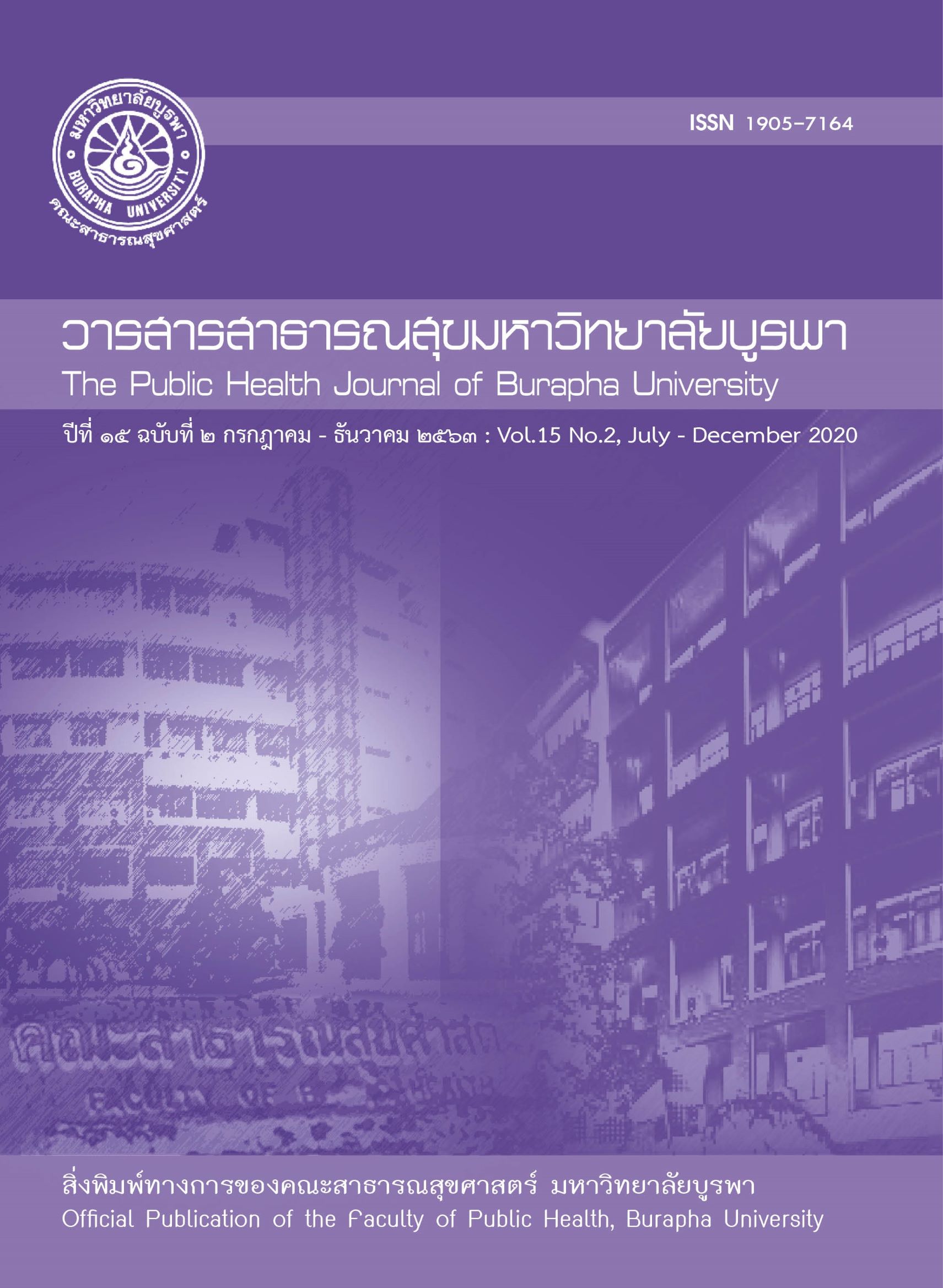การศึกษาความตระหนักรู้ ความคาดหวัง และพฤติกรรมการใช้ยาปฏิชีวนะ ของผู้ใช้บริการ ร้านยาในเขตเทศบาลเมืองแสนสุข จังหวัดชลบุรี
Main Article Content
บทคัดย่อ
Consumers’ Awareness, Expectation, and Behaviors related to Antibiotic Use of Consumers in Community Pharmacies in Saensuk Municipality, Chonburi Province
งานวิจัยนี้มีวัตถุประสงค์เพื่อประเมินระดับความตระหนักรู้เกี่ยวกับการใช้ยาปฏิชีวนะและสถานการณ์ดื้อยาปฏิชีวนะ ความคาดหวังต่อการได้รับยาปฏิชีวนะและการบริบาลทางเภสัชกรรม และพฤติกรรมการใช้ยาปฏิชีวนะของผู้ใช้บริการร้านยาในเขตเทศบาลแสนสุข จังหวัดชลบุรี โดยใช้วิธีการศึกษาเชิงสำรวจแบบภาคตัดขวาง กลุ่มตัวอย่างมีอายุตั้งแต่ 18 ปีขึ้นไป ที่ใช้บริการร้านยาและพักอาศัยในเขตเทศบาลแสนสุข จำนวน 471 คน เก็บรวมรวบข้อมูลด้วยแบบสอบถามซึ่งผ่านการตรวจสอบความเที่ยงตรงเชิงเนื้อหาและความเชื่อมั่นของแบบสอบถามแล้ว วิเคราะห์ข้อมูลโดยใช้สถิติเชิงพรรณนาและไคสแควร์ ผลการศึกษาพบว่า คะแนนเฉลี่ยความตระหนักรู้เกี่ยวกับการใช้ยาปฏิชีวนะและความตระหนักรู้ต่อสถานการณ์ดื้อยาปฏิชีวนะ ความคาดหวังต่อการได้รับยาปฏิชีวนะและการบริบาลทางเภสัชกรรมในร้านยา และพฤติกรรมการใช้ยาปฏิชีวนะของกลุ่มตัวอย่างมีคะแนนเฉลี่ยรวมเท่ากับ 70.37, 81.33, และ 73.80 ตามลำดับ ซึ่งคะแนนเฉลี่ยทั้งสามด้านนี้จัดอยู่ในระดับดี อย่างไรก็ตามพบว่ากลุ่มตัวอย่างที่มีอายุระหว่าง 18-23 ปี มีความตระหนักรู้เกี่ยวกับการใช้ยาปฏิชีวนะและสถานการณ์ดื้อยาปฏิชีวนะ น้อยกว่ากลุ่มตัวอย่างที่อายุมากกว่า 23 ปีขึ้นปี อย่างมีนัยสำคัญทางสถิติ (p-value < 0.001) ทั้งนี้เภสัชกรควรเพิ่มบทบาทในการส่งเสริมและสนับสนุนให้เยาวชนในชุมชนมีระดับความตระหนักรู้สูงขึ้น รวมทั้งสนับสนุนให้ประชาชนในชุมชน มีคะแนนเฉลี่ยทั้งสามด้านเพิ่มสูงขึ้นได้อีก โดยเพิ่มช่องทางและรูปแบบการให้ความรู้ที่สอดคล้องกับรูปแบบการดำเนินชีวิตของคนในปัจจุบัน
This study aims to evaluate levels of awareness of antibiotic use, resistance, expectation of receiving antibiotics, clinical pharmacy services, and behavior of antibiotic uses of the consumers in community pharmacies in Saensuk Municipality, Chonburi Province. A cross-sectional survey study was conducted. Participants were 18 years old and over, customers of community pharmacies and lived in Saensuk Municipality. Data were collected by self-administered questionnaires with acceptable content validity and reliability. There were 471 questionnaires usable for analysis. Descriptive and Chi-square statistics were used for the data analysis. The results showed that the average total scores of the awareness, expectation, and behavior of antibiotic use were 70.37, 81.33, and 73.80, respectively. The scores were considered at a good level. However, the results found that participants aged 18-23 years old had significantly lower scores (p-value < 0.001) in the awareness of antibiotic uses and resistance than participants aged above 23 years old. Community pharmacists should, therefore, increase their roles supporting young people to gain higher levels of awareness. Moreover, the pharmacists should encourage people in the community to try in getting more appropriate information regarding antibiotic use so that their scores of the three parts can be increased. This can be done by expanding communication channels to provide correct knowledge and information to the consumers in accordance with their current lifestyles.
Article Details
References
2. Luvira V. Overveiw of antibiotic resistance. Songkla Med J. 2006;24(5):453-9.
3. World Health Organization. Antimicrobial resistance: global report on surveillance: World Health Organization; 2014.
4. O’Neill J. Antimicrobial resistance: Tackling a crisis for the health and wealth of nations [Internet]. 2014 [cited 2018 Feb,5]. Available from: https://amr-review.org/sites/default/files/AMR%20Review%20Paper%20-%20Tackling%20a%20crisis%20for%20the%20health%20and%20wealth%20of%20nations_1.pdf.
5. Percentage of susceptible organisms isolated from all specimen, 44 hospitals [Internet]. 2017 [cited 2018 Feb,5]. Available from: https://narst.dmsc.moph.go.th/antibiograms/2017/9/Jan-Sep2017-All.pdf.
6. Phumart P, Phodha T, Thamlikitkul V, Riewpaiboon A, Prakongsai P, Limwattananon S. Health and economic impacts of antimicrobial resistant infections in Thailand : a preliminary study. 2012;6(3):352-60.
7. กระทรวงสาธารณสุข กระทรวงเกษตรและสหกรณ์. แผนยุทธศาสตร์การจัดการการดื้อยาต้านจุลชีพ ประเทศไทย พ.ศ. 2560-2564 [Internet]. 2017 [cited 2018 Feb,5]. Available from: https://narst.dmsc.moph.go.th/documentation/AMR%20strategy%202560-2564.pdf.
8. International Pharmaceutical Federation (FIP). Fighting antimicrobial resistance: The contribution of pharmacists. The Hague: International Pharmaceutical Federation; 2015.
9. World Health Organization. Antibiotic resistance: Multi-country public awareness survey. 2015.
10. Davis ME, Liu TL, Taylor YJ, Davidson L, Schmid M, Yates T, et al. Exploring patient awareness and perceptions of the appropriate use of antibiotics: a mixed-methods study. Antibiotics (Basel, Switzerland). 2017;6(4).
11. จิรชัย มงคลชัยภักดิ์, จิรวัฒน์ รวมสุข, เอมอร ชัยประทีป. การศึกษาความรู้และพฤติกรรมเกี่ยวกับการใช้ยาปฏิชีวนะของผู้รับบริการ ในร้านยาชุมชนจังหวัดปทุมธานี. EAU HERITAGE. 2012;6(2):91-100.
12. มารยาท โยทองยศ, ปราณี สวัสดิสรรพ์. การกำหนดขนาดของกลุ่มตัวอย่างเพื่อการวิจัย [Internet]. [cited 2018 Feb,5]. Available from: https://www.fsh.mi.th/km/wp-content/uploads/2014/04/resch.pdf.
13. Topor G, Grosu IA, Ghiciuc CM, Strat AL, Lupusoru CE. Awareness about antibiotic resistance in a self-medication user group from Eastern Romania: a pilot study. PeerJ. 2017;5:e3803.
14. Best JW, Kahn JV. Research in Education: Pearson/Allyn and Bacon; 2006.
15. Lynn MR. Determination and quantification of content validity. Nursing research. 1986.
16. Tavakol M, Dennick R. Making sense of Cronbach's alpha. International journal of medical education. 2011;2:53.
17. พิชชนันท์ อุยยานุกูล, รัศมน กัลยาศิริ. ความชุกและปัจจัยที่เกี่ยวข้องของหญิงตั้งครรภ์ที่ได้รับควันบุหรี่มือสองจากที่บ้านหรือที่ทำงานในระหว่างตั้งครรภ์. เวชศาสตร์ร่วมสมัย. 2016;60:693-4.
18. Sirijoti K, Hongsranagon P, Havanond P, Pannoi W. Assessment of knowledge attitudes and practices regarding antibiotic use in Trang province, Thailand. Journal of Health Research. 2014;28(5):299-307.
19. Suaifan GA, Shehadeh M, Darwish DA, Al-Ije H, Yousef A-MM, Darwish RM. A cross-sectional study on knowledge, attitude and behavior related to antibiotic use and resistance among medical and non-medical university students in Jordan. African Journal of Pharmacy and Pharmacology. 2012;6(10):763-70.
20. Vallin M, Polyzoi M, Marrone G, Rosales-Klintz S, Wisell KT, Lundborg CS. Knowledge and attitudes towards antibiotic use and resistance-a latent class analysis of a Swedish population-based sample. PloS one. 2016;11(4):e0152160.
21. Saengcharoen W, Lerkiatbundit S, Kaewmang K. Knowledge, attitudes, and behaviors regarding antibiotic use for upper respiratory tract infections: a survey of Thai students. Southeast Asian Journal of Tropical Medicineand Public Health. 2012;43(5):1233.
22. Aunruean W, Saensom D. Behavior of KKU students on antibiotics use in sore throat, clean wound and acute diarrhea. KKU Institutional Research. 2015;3(3):221-32.
